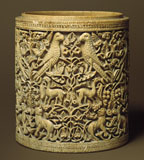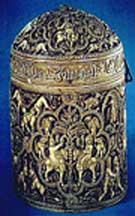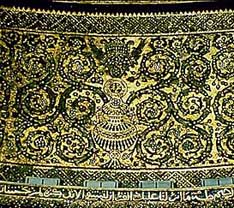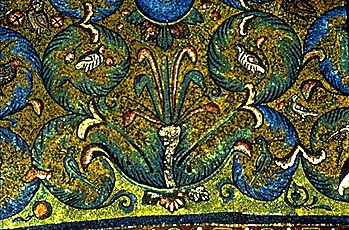Vegetal Designs in Islamic Art
Not simply "ornament", vegetal scrolls and other designs arguably have meanings beyond decoration. Francisco Prado-Vilar argues that 8th-10th century ivory caskets, which are often covered in vegetal scrolls, were created for different reasons.
1 For instance, an ivory
pyxis covered in vegetal scrolls refer to feminine beauty. Other types of ivory caskets were commissioned as gifts for men, but typically these used a different style that showed a court influence. Images of the power and elegance of court life cover these objects found throughout the courts of Spain.


The
pyxis made for al-Mughira is not simply a luxury item covered in courtly decoration. Instead, it is a luxurious gift that immasculates the courtly figure, al-Mughira.
2 The shape of the pyxis is used primarily for female recepients, not male, because of the similarity in shape to a breast. The vegetal ornament, furthermore, indicates the feminine message of this object, casting doubt on al-Mughira's manhood now that he is possession of such an object.
The Dome of the Rock in Jerusalem (691), an
Umayyad political and religious monument, utilizes vegetal designs to symbolize Paradise. The vegetal scrolls are supposed to represent the lush gardens and riches that await the devout Muslim.
3 While decorative, this ornament does have a meaning to the viewer, and does not simply cover blank areas. There are messages conveyed through decoration.
These vegetal designs in the hands of Christians could easily refer to these ideas of courtly culture, as well as ideas of Paradise, since both concepts factor into Christian life. As seen in the
Alcazar in Sevilla, courtly culture could be displayed through the decoration of a court or palace. Also, vegetal themes, seen in
Sevilla and other Christian cities, refer to Paradise (Heaven). Aside from these categories, vegetal designs have been used by Christians to show their power over Muslims, similar to the ideas behind the vegetal designs that immasculated al-Mughira.
Ivory pyxis made for princess Subh in 964
Mosaic detail from Dome of the Rock
Mosaic detail from the Church of San Vitale, Ravenna




